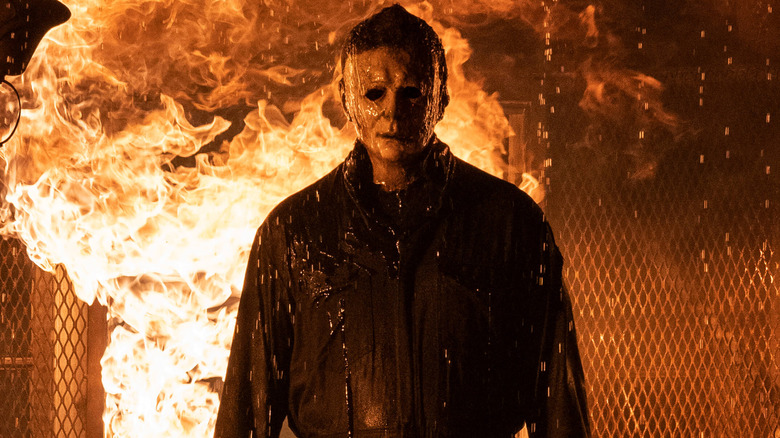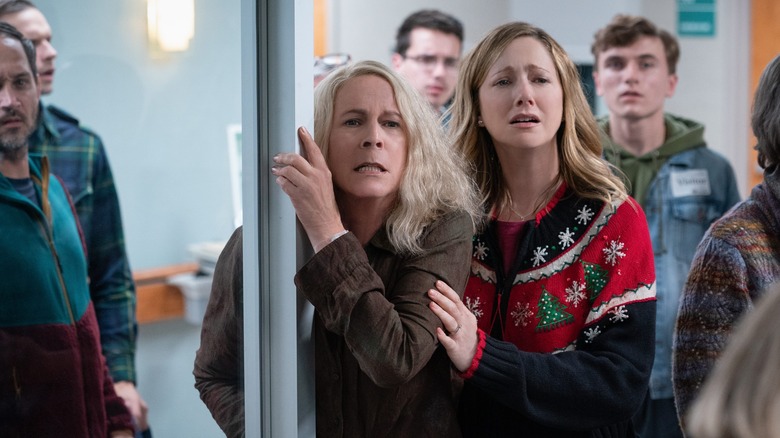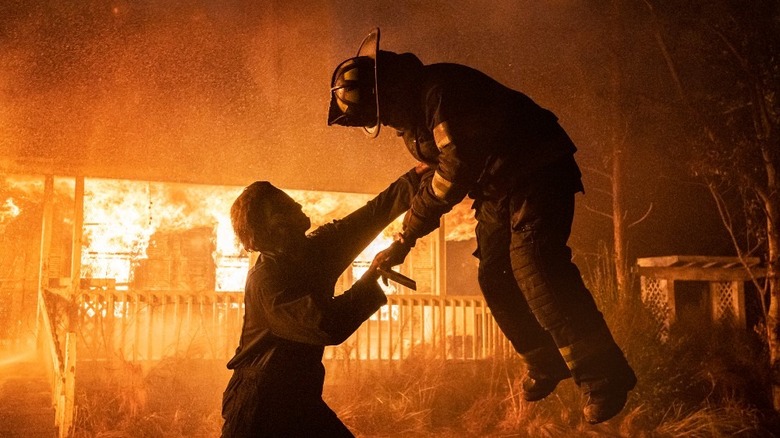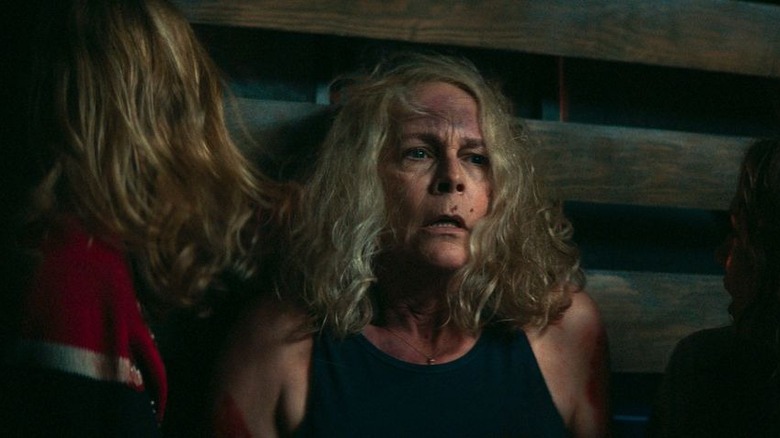Halloween Kills Director David Gordon Green Made A Rock 'N' Roll Sequel [Interview]
"Halloween Kills" is a bloodbath. Director David Gordon Green's sequel turns up the gore, the comedy, and the pace in the sequel to the hit reboot, which brought Laurie Strode (Jamie Lee Curtis) back. Like most sequels, "Halloween Kills" goes bigger, especially in the kills department. Not only are they nasty and impressive pieces of craftsmanship from the VFX department, but they are surprising — sometimes even shocking.
Green wanted the sequel to go a little nuts, especially after earning the trust of most "Halloween" fans with his 2018 soft reboot/sequel. "It's tricky doing a middle chapter of a trilogy; making sure it feels satisfying within its own walls of beginning, middle and end," he told us in an interview ahead of the release of the highly anticipated "Halloween" sequel. "When you know it's not going to end."
Soon enough, Green will shoot the final chapter in his trilogy. As for the middle chapter, the filmmaker recently told us a bit about his approach to the sequel, as well as his collaboration with original "Halloween" director John Carpenter.
"It's tricky doing a middle chapter of a trilogy..."
The last "Halloween" was more old school suspense, but this plays as the more rock and roll sequel. What made you want to go more nuts with the sequel?
With the first film, it was to be very, very specific of the integrity of these characters, and the legacy of John Carpenter. And here, I felt like since we found our success with the first film, we got the audience's trust, for the most part. Now, we can let it rip a little bit. And so, that was kind of the fun. How do we open it up and show a more expansive portrait of Haddonfield, a more communal experience of fear, and take some of those legacy characters, combine them with some of the characters that we brought to the table in our 2018 film, and just go a little nuts? We had a great time doing it. It's tricky doing a middle chapter of a trilogy; making sure it feels satisfying within its own walls of beginning, middle and end. When you know it's not going to end.
Does "Halloween Kills" stick pretty closely to the original idea you all had for a sequel?
There was exploring, but Danny McBride and I are co-writers in all three of the films. In each of the films, we bring in a new co-writer. The first film was Jeff Fradley, who was our old film school bud, and "Halloween" freak. And the second film, we brought in Scott Teems, who's a filmmaker we both admired, and had a different perspective. So, we had ideas. We brought him in and said, "What are your ideas?" We'd spitball with the think-tank at Blumhouse, and our own collaborators. Literally, we brought back every department head, and the majority of the crew from our last film, and our dolly grips, at the table reads, giving ideas. And so, it's just a fun way to play; expand on the seeds that we planted, and take it to the next level.
"Before I even knew what a director was, I was enjoying his movies."
Do you still find yourself going to John Carpenter and asking questions?
Constantly. Not for a first draft. I'm all terrified to show him a first draft, or a first cut. Once I like it, and I feel this is the path we're on, now I bring him in and get his criticism, and inspirations, and ideas. That's very important to me on the script level. And then, when we're in production, I'll usually check in with him a couple times. But then, when we're editing, I'll put together an assembly, and then, very frequently, I'll watch him watch cuts. It is totally trippy, because he is one of my filmmaking idols. I'll be on a Zoom link watching him watch it, and he'll turn around and give me his commentary and thoughts. And then, as a collaborator, his incredible and essential contribution as a musician with his son, Cody, and [composer] Daniel Davies. It is as inspiring as you'd hope it would be for someone who you just admired your entire life. Before I even knew what a director was, I was enjoying his movies.
We just got his notes on the third installment. So, that's great. And being able to apply, and address, and consider his perspective on some other things for how we're going to end this trilogy.
The score rocks in this movie. What did you both want it to achieve?
We wanted that. When you say it's a "rock and roll" chapter, one of the things that [Carpenter] does so well, is rock and roll. Not only are there some distinctive new tracks to deviate a little bit from his traditional score, which I love, but we also have, in one of the opening scenes of the movie, an homage to his band The Coupe De Villes. There are some triplets on stage singing a song that is at a bar, and that's a song from his heyday with Tommy Wallace and Nick Castle, and a band that they were in back in the '80s. There are a lot of Easter eggs just for Carpenter fans. Outside of the obvious fandom of Michael Myers and Laurie Strode, there are some things in there that it's just fun to share with people that have grown up feeling inspired by John.
With the flashbacks, how'd you and Mike Simmons want to capture the aesthetic and feel of the original film?
Our DP, Mike Simmons, reached out to Dean Cundey, who shot the original film. He gave him a lot of specifics on how to light, and the direction of lighting, the color of lighting. The movement of camera is significantly less than our 2018 story. So technically, it's less aggressive editing. Everything is a little bit more composed and considered, in that way. It's really valuable for our art department to study the production design, and for our camera department to study how it was shot. Do that research and have that authority.
"This one was definitely leaning into the chaos."
Do you still look at any of the "Halloween" movies beyond the original for inspiration?
Other than some "Seasons of the Witch," there is an obvious homage there, and acknowledgement of that, but there's not a ton. I flirted with the idea of getting Paul Rudd in the film; things like that, that ended up not happening. There's a lot of fun I had. Before we did the 2018 version, I watched all the films again a couple of times. I didn't really find too much applicable to what we were doing, but I've been promising myself I'd re-watch them all anyway before we do "Halloween Ends," and see if any other little notes that we can appreciate from the other films of the franchise. I actually enjoyed them a lot. I didn't really feel like their narrative was going to stick to what we were trying to do, but I enjoy them just as a fan.
When it comes to writing kills, which this movie ups the ante on, how do you know when you've struck the right kill for a scene?
Well, you always try to find unique and innovative ways to do it, but you want it to be realistic within an environment. So it would be, very often, me, and Danny, and Scott walking around in our living rooms and kitchens, trying to find things that would be unique. New ways to present a sequence, and then talking to our makeup and effects genius, Chris Nelson, about how to actually execute it. And then other times, I was thinking one day, "I don't know that I've ever seen anybody get stabbed in the armpit in a movie. Where could we squeeze that in?" And then, you look through all your kills and think, "Ah, here we go."
Those were really fun sequences. And there's also things, in the editing room, you can usually [say], "A little more, a little less. Are we going to be more subtle? Are we going to be more overt with our violence?" And this was a movie that, when we got into the groove of it, the violence was part of the fun artistry of it. And so, we lean into it a little bit. Certainly, significantly more than the previous chapters. And yet to be seen, where we'll go on the third with it, but this one was definitely leaning into the chaos.
"Halloween Kills" is now playing in theaters.



